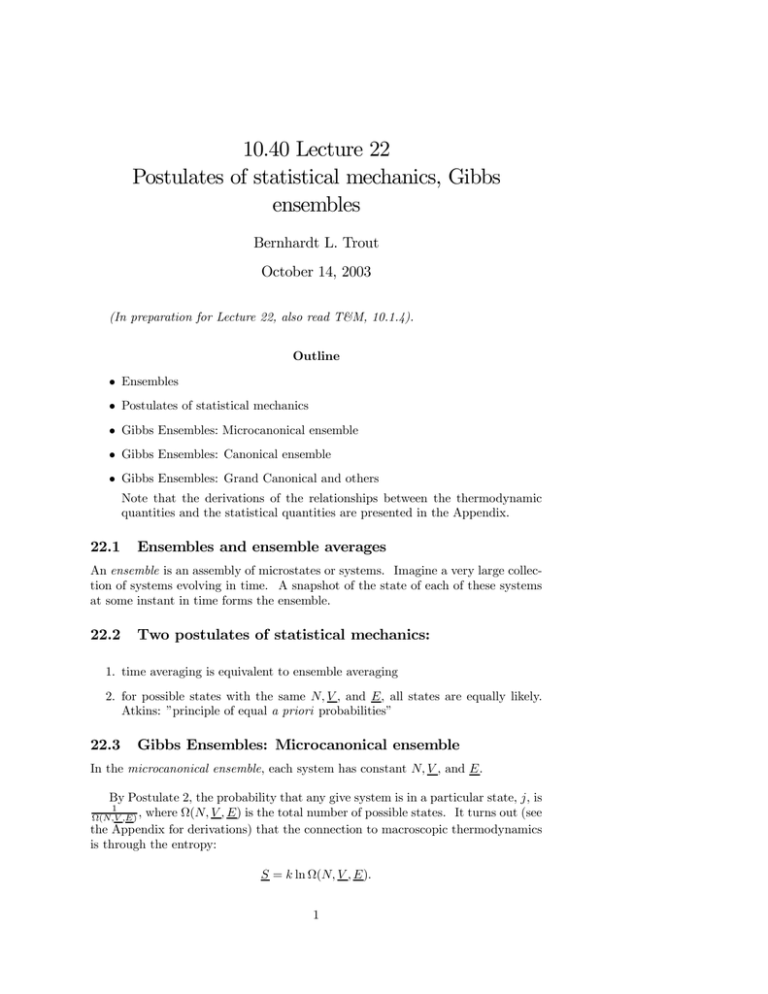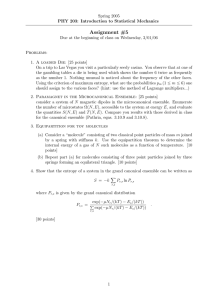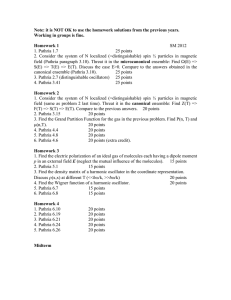10.40 Lecture 22 Postulates of statistical mechanics, Gibbs ensembles Bernhardt L. Trout
advertisement

10.40 Lecture 22 Postulates of statistical mechanics, Gibbs ensembles Bernhardt L. Trout October 14, 2003 (In preparation for Lecture 22, also read T&M, 10.1.4). Outline • Ensembles • Postulates of statistical mechanics • Gibbs Ensembles: Microcanonical ensemble • Gibbs Ensembles: Canonical ensemble • Gibbs Ensembles: Grand Canonical and others Note that the derivations of the relationships between the thermodynamic quantities and the statistical quantities are presented in the Appendix. 22.1 Ensembles and ensemble averages An ensemble is an assembly of microstates or systems. Imagine a very large collection of systems evolving in time. A snapshot of the state of each of these systems at some instant in time forms the ensemble. 22.2 Two postulates of statistical mechanics: 1. time averaging is equivalent to ensemble averaging 2. for possible states with the same N, V , and E, all states are equally likely. Atkins: ”principle of equal a priori probabilities” 22.3 Gibbs Ensembles: Microcanonical ensemble In the microcanonical ensemble, each system has constant N, V , and E. By Postulate 2, the probability that any give system is in a particular state, j, is 1 Ω(N,V ,E) , where Ω(N, V , E) is the total number of possible states. It turns out (see the Appendix for derivations) that the connection to macroscopic thermodynamics is through the entropy: S = k ln Ω(N, V , E). 1 10.40: Fall 2003 Lecture 22 2 (Ensemble of systems) N,V,E N,V,E N,V,E ... ... N,V,E Figure 1: Microcanonical ensemble 22.4 Gibbs ensembles: Canonical ensemble In the Canonical ensemble, each system has constant N, V ,and T. After equilibration, remove all of the systems from the bath, and put them all together: Here, the connection is through the Helmholtz Free Energy: A= −kT ln Q(N, V , T ) Similarly, S P U = − µ ∂A ∂T ¶ = kT V ,N µ µ ¶ + k ln Q V ,N ¶ ∂ ln Q = kT = − ∂V T,N T,N µ ¶ ∂ ln Q = A + T S = kT 2 . ∂T V ,N µ ∂A ∂V ¶ ∂ ln Q ∂T Thus, all thermodynamic properties can be written in terms of the partition function, Q(N, V , T )! In order to compute Q, all we need are the possible energy levels of the system. We can obtain these from solving the equations of quantum mechanics. 22.5 Gibbs Ensembles: Grand Canonical and others In the Grand Canonical ensemble, the number of particles in each system is allowed to fluctuate, but µ is kept constant. This is called the (V , T, µ) ensemble. Also, there are other ensembles, such as (N, P, T ), etc. Note that from an analysis of fluctuations (Lecture 27), we shall see that in the macroscopic limit of a large number of systems, all of these ensembles are equivalent. The choice of which one to use is made for convenience. 2 10.40: Fall 2003 Lecture 22 3 (Ensemble of systems) N,V,EA ... N,V,EB N,V,EC ... N,V,Ej (Bath at temperature T) Figure 2: Canonical ensemble N,V,EA N,V,EB N,V,EC ... N,V,Ej ... Figure 3: Canonical ensemble forming its own bath 3






